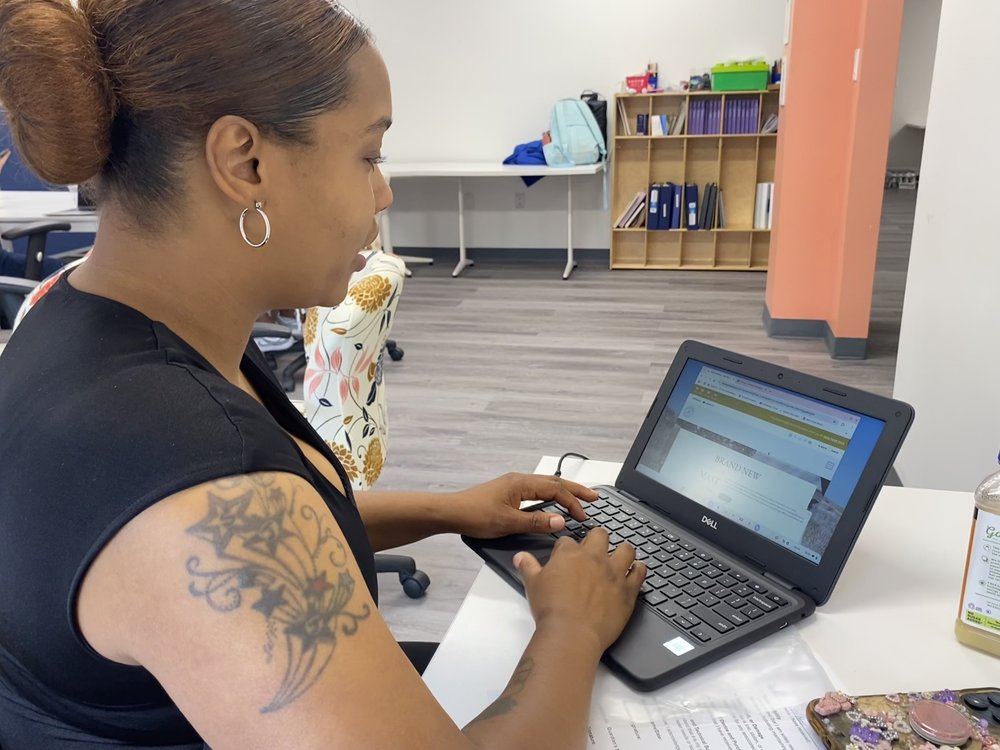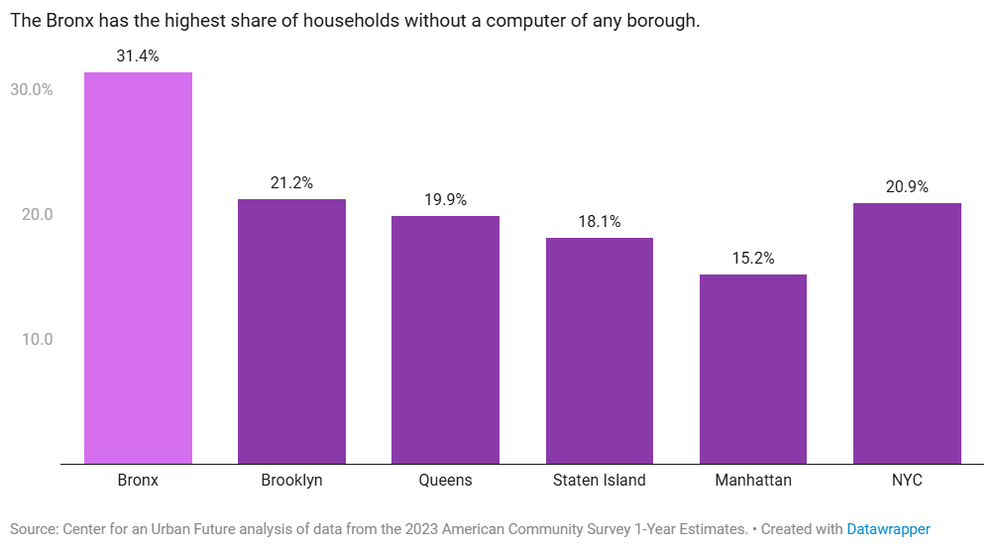It’s 2025, but a quarter of Bronx families don’t have broadband internet at home
Aug. 18, 2025, 12:01 p.m.
The digital divide in the Bronx is the worst among all the boroughs, a new report found.

Al Christian says he doesn’t have internet at his Bronx home because he can’t afford the utility bill. That makes it hard to look for work since most applications and job listings are now online. It also means he can’t watch YouTube, listen to music or FaceTime his adult daughter.
“There's a lot of things you would like to find out on the internet and without that, you ain't really got nothing,” said Christian, 59. “ You can't do a lot.”
April Zarks has Wi-Fi, but doesn’t own a computer in her East Tremont home so she has to read the news on her phone and can’t apply for remote jobs without a device.
“Sometimes it would be better to work with a bigger screen being I have poor vision,” said Zarks, 58.
Internet bills in New York City can range from $30 to $100, and laptops can tack on another $300-$500 or more — expenses that can be out of reach for New Yorkers struggling to pay rising rent, food and child care costs. The affordability crisis is fueling the digital divide in New York City’s poorest borough, where 1 in nearly 4 homes lack broadband internet and 1 in 3 don’t have computers, according to a recent report by the Center for an Urban Future.
Overall, the report finds, 19% of Bronx households rely on only on smartphones for home internet access.
"The internet is no longer a luxury, it's an essential service," City Hall spokesperson Kayla Mamelak-Altus said. She said the city's efforts to address the problem include delivering free broadband to hundreds of thousands of NYCHA residents through its Big Apple Connect program and providing free internet to 2,000 households across the Bronx and Upper Manhattan. She said the city also spent $2.4 million to expand digital access in underserved communities and expanded the LinkNYC kiosks that provide free WiFi.
Advocates say a lot of progress has been made in wiring 99% of the borough with broadband, but they worry Bronx families will fall further behind without more investment from city and state officials. This is especially true as residents’ budgets tighten amid federal cuts to programs that help people afford groceries through SNAP or health insurance through Medicaid.
“ The digital divide has become a major driver of inequality in New York. It is separating New Yorkers into those who not only have access to computers and broadband but with those things, access to a full world of opportunity, from education to job training, to opportunities to connect with programs and services that could change the trajectory of their lives,” said Eli Dvorkin, co-author of the Center for an Urban Future report.
1 in 3 households lack computers
Malika Butler, 37, remembers when she applied to Metropolitan College of New York — on her phone.
“It was a little difficult because sometimes it restarts, sometimes your phone freezes, sometimes you lose internet service,” she said. “But as long as you keep pushing through it, you'll get it done.”

She went on to graduate with a bachelor’s degree in human services and is working on launching her own businesses providing resources for women. But with her oldest son headed to trade school to become an automotive mechanical engineer, she knew he needed a laptop for his studies. Butler was able to get a laptop from the organization LIFT New York, an organization working to break the cycle of poverty, after taking some courses around parenting in the digital age. She said getting a free laptop was a weight off her shoulders.
“Having the laptop is going to help him, not only help him to be able to be successful and to be able to do his goals and complete everything that he needs to, but it also gives mom a little bit like, a relief,” she said.
Giselli Veloz, LIFT's senior program manager of community engagement, said the parents the group serves can’t always afford to purchase computers for their kids, especially when everyone needs a device for school or work. Others can’t afford the internet bill.
“It's not always easy to pay $70 when you're a single parent and maybe receiving public benefits. Those $70 can purchase diapers. Those $70 are purchasing clothing, school supplies, other basic needs,” she said.
Despite the fact that more than 30% of Bronx households lack computer at homes, the borough also has among the lowest number of public computer labs.
Derrick Lewis, co-founder of the Bronx Community Foundation, which commissioned the report, said the digital divide is solvable but city and state officials need to scale up programs that are already working in the Bronx, such as laptop lending initiatives, broadband internet locations, as well as invest in training the next generation by growing tech and computer science training programs at CUNY.
“Everything is digital these days, whether it's access to your benefits, whether it's being able to work from home, being able to school from home, everything we do every single day is digitally aware and digitally enabled,” Lewis said. “That certainly over time, will become equally important as access to food, access to a roof over your head.”
Nearly 250,000 households in the Bronx — or 44% — were enrolled in a federal program that paid a monthly credit to internet service providers for low-income families. That ended last year, booting families off affordable broadband internet. This year the state’s Affordable Broadband Act took effect this year, which requires internet service providers to offer discounted plans of $15 or $20 a month to low-income households.
”The problem is we're starting from scratch,” Dvorkin said. “ There's a long way to go to actually boost uptake from what is basically back to square one.”
This story has been updated to include a comment from a City Hall spokesperson.
Many NYC homeless shelter residents can’t access Wi-Fi. 2 new bills hope to change that. 1 million NYC households set to lose high-speed internet